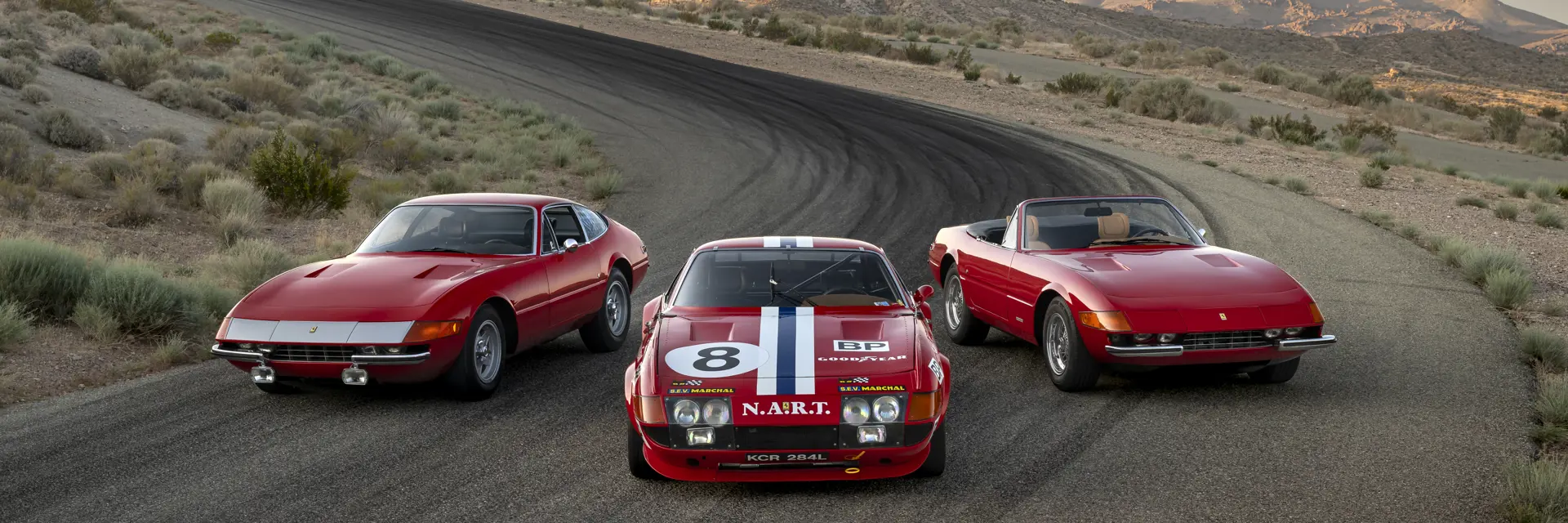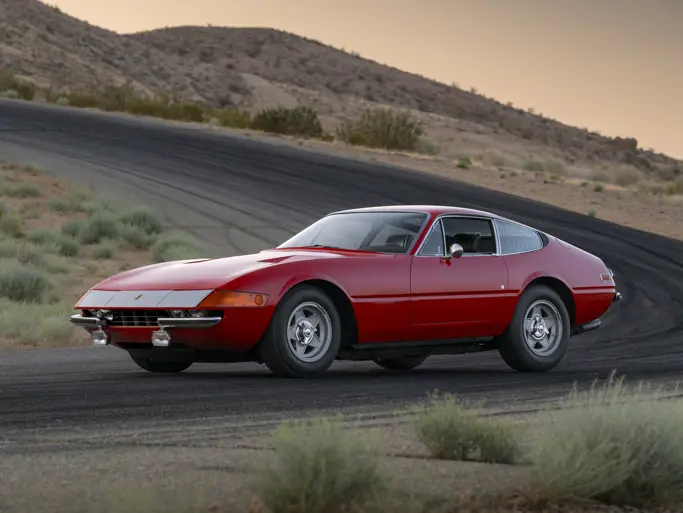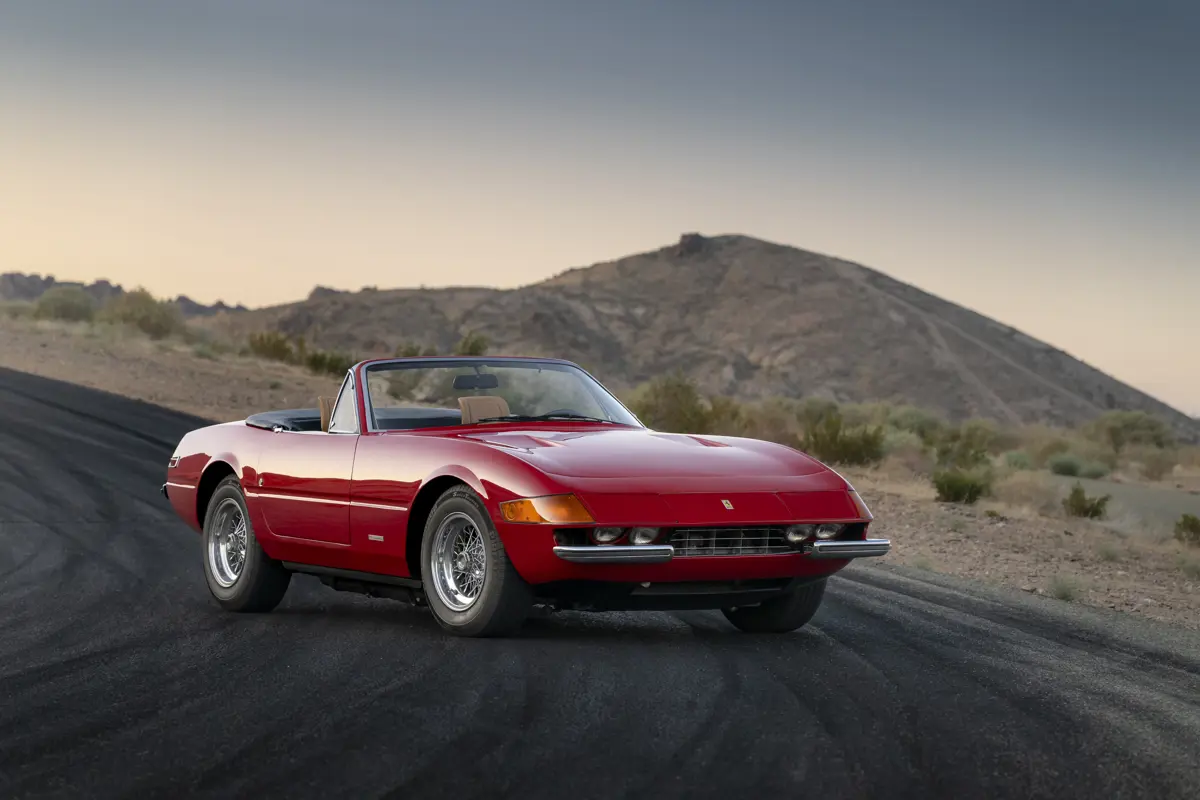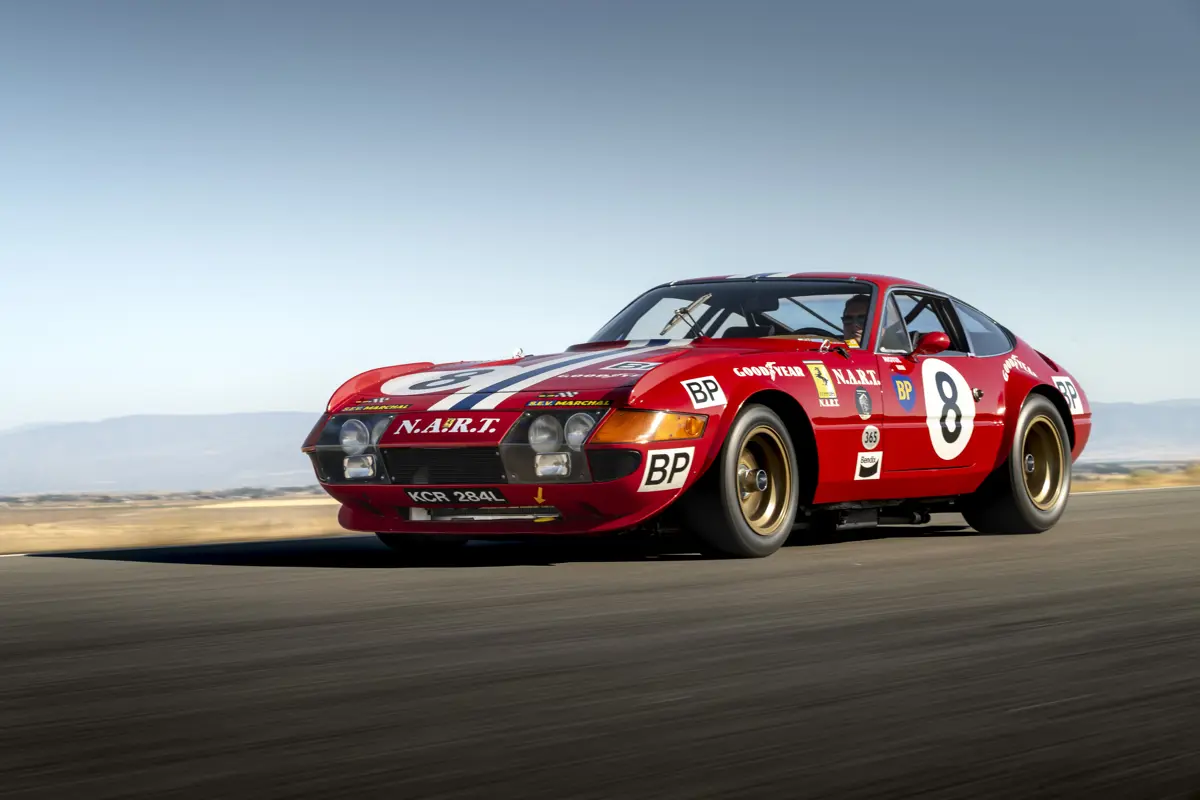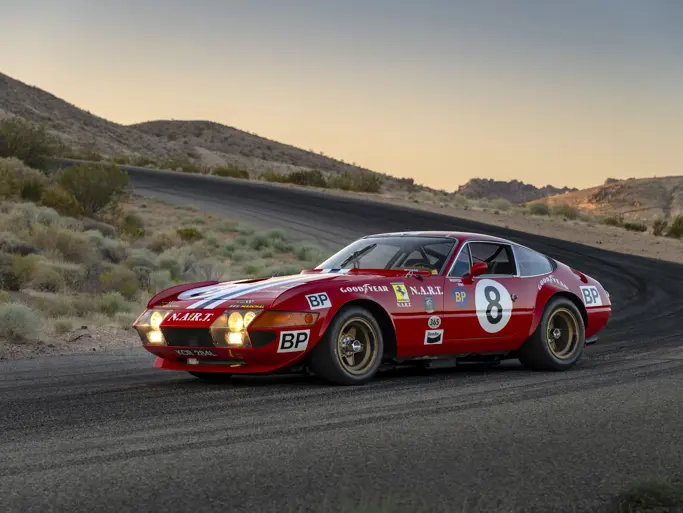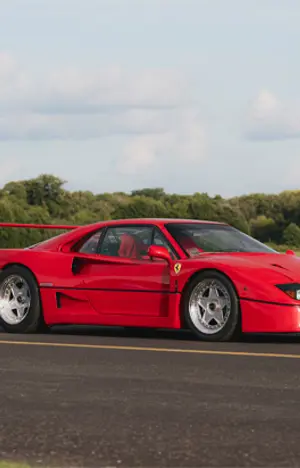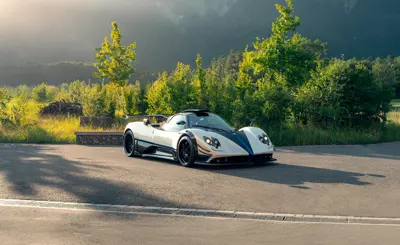The gates of Ferrari’s headquarters in Maranello, Italy have seen sports cars with a stunning variety of monikers roll past over the company’s 78-year existence, but few model names have had quite the enduring cache of the one named for a beach in Florida: Daytona. Which is somewhat ironic, considering Ferrari doesn’t formally acknowledge the term; according to the manufacturer, it’s merely an “unofficial name” for the grand tourer officially called the 365 GTB/4.
But while the proper name may sum up the car’s per-cylinder displacement, body type, and cam count to those in the know, it fails at conjuring up much in the way of emotion the way “Daytona” does. The nickname derives from Ferrari’s impressive finish at the 24 Hours of Daytona, where the company’s race cars claimed all three spots on the podium in the 1967 race—a finish apparently notable enough to still be in the minds of journalists when the car made its debut at the Paris Auto Salon in the autumn of 1968 as the first new model revealed since the big victory 20 months before. It was the latest in the company’s proud tradition of sports cars with 12-cylinder engines mounted up front—the car that would carry the Ferrari archetype laid down in the 1940s into its fourth decade.
“The Daytona was probably the most pivotal model of the 1970s era” for Ferrari, says Jarrett Rothmeier, Senior Vice President Private Sales, Head of Research and Collections Development for RM Sotheby’s. “It was more or less the final evolution of the great front-engined GT Ferraris that they built.”
“They hold a special place in Ferrari history."
The heart of any Ferrari is its engine, and the 365’s was a honey: a 4.4-litre V-12 with a bore of 81 millimetres and a stroke of 71 millimetres, and a sextet of Weber 40 carburettors, helping to unleash a claimed 352 brake-horsepower at 7,500 rpm. A five-speed manual transaxle, in turn, routed that power to the rear wheels, the combination capable of propelling it to a top speed of 174 mph, knocking out the first kilometre of progress in just 24 seconds.
British automotive publication Autocar and American car magazine Road & Track both put examples to the test in the early 1970s, and saw impressive results for the era: both clocked the 0-100 mph run at 12.6 seconds, while the former saw a 0-60 of 5.4 and the latter the same run in 5.8. The American test car was also a bit behind in the quarter mile—its 14.5 seconds at 107.5 mph lagged the UK’s 13.4 at 104—but R&T’s Competizione hit a higher top speed of 186 mph versus Autocar’s 174, suggesting perhaps that the American version had taller gearing.
“There’s a ton of power, and they’re huge fun to drive,” Rothmeier says.
Stylistically, the 365—with a body penned by Pininfarina’s Leonardo Fioravanti and built by Scaglietti, being among the last cars made by the coachbuilder—was a significant break from the 250 and 275 that preceded it in showrooms. The Daytona traded in those cars’ slippery post-war looks for tighter haunches, a larger greenhouse, and sharp angles—most notably, a front end that looked sharp enough to serve as King Kong’s razor. The latter effect was increased by a change halfway through the car’s life; while original models boasted exposed headlamps behind Plexiglas, changing US laws in the early 1970s caused the design team to pivot for the 1971 model year, switching over to the flip-up lights that would define the brand for decades to come. It was unlike any Ferrari that had come before, yet instantly recognisable, and stunningly cool.
Perhaps as a result, the car had a greater impact on pop culture than your average Ferrari. A 365 GTB/4 carried racing legend Dan Gurney and journalist Brock Yates to victory in the first installment of the East Coast-to-West-Coast vehicular sprint known today as “The Cannonball Run.” It showed up in films like The Long Goodbye and A Star Is Born, and in the driveways of rock gods like Eric Clapton, Roger Waters, and Elton John. And, of course, it practically served as the third lead actor of television’s Miami Vice during the show’s first two seasons—although the TV car’s actual provenance as a Corvette-based replica led Maranello to demand its destruction, in exchange for a crisp white Testarossa for Don Johnson to drive.
The Daytona’s legacy also extends into later eras of street cars. While it would prove Ferrari’s final front-engined V-12 two-seater for more than two decades, with the brand migrating away from the style in favour of mid-mounted flat-12s, the manufacturer returned to the layout with the 550 Maranello of 1996, and has been putting out V-12-powered sports cars with their engines in front of the cockpit ever since. None of those better represent the 365 GTB/4’s impact than the latest 12-cylinder model, the 12Cilindri: its design is immediately recognisable as inspired by the Daytona of more than five decades before.
Three main versions were available during the Daytona’s production run of a little less than 1,400 vehicles: a hardtop coupé, a soft-top roadster, and a racing version. As is Ferrari tradition, of course, they each wore names that might seem unfamiliar to the proletariat: Berlinetta, Spider, and Competizione.
Ferrari 365 GTB/4 Daytona Berlinetta
“Berlinetta” is Italian for “little saloon,” and it’s been applied to Ferrari’s hardtop sports cars informally since the late 1940s and officially since 1956, when it first appeared on the 250 GT Berlinetta. For the Daytona, it appears in the last letter of its formal alphanumeric name, with the first two standing for “Gran” and “Turismo,” respectively. It was the first version of the 365 to be seen, and was the most commonly built variant—though of course, no Daytona is exactly common.
Early examples featuring the model’s distinctive fixed headlamps and Plexiglas nose are among the most sought-after Daytonas, accounting for around one-third of production before the switch to pop-up lamps in 1971—though the actual number will be lower due to many having been updated after being crashed. More important, however, is condition, with original and unrestored Daytonas of any type commanding a large premium over those that have undergone restoration.
On 26 June 2025, one of the finest and best-preserved 365 GTB/4 Daytonas will be offered via Sealed. With fewer than 2,000 miles on the odometer, it represents one of the least-driven Daytonas in existence.
As a result, Rothmeier says, it’s far closer to factory condition than any Daytona you’re likely to see on the concours field, as modern restoration shops tend to rebuild cars to a higher standard even than Maranello did in the Disco Era.
“There are very few cars from the 1970s that remain true time capsule pieces for originality,” Rothmeier says, “and certainly there are few cars from that era that still have under, let’s call it 5,000 original miles, let alone closer to 2,000 original miles.”
More compelling still, the Daytona boasts a unique ownership history. The first of its two owners, Willet Brown, played a major role in bringing Ferrari to the United States in the first place, serving as a business manager for his friend, dealership owner Tommy Lee, and even taking over Lee’s business after his death in 1950. Brown’s 365 GTB/4 made its way into his hands in 1972, and stayed in his garage until his death in 1993, eventually being auctioned off by Sotheby’s two years later in a sale of Brown’s 161-lot private collection. Since then, it’s been tucked away in the current custodian’s collection—seldom-driven but greatly loved.
Ferrari 365 GTB/4 Daytona Spider
The term “spider” (sometimes also spelled “spyder”), which stems from the term for a type of lightweight open-air horse-drawn carriage, has become commonplace among manufacturers as shorthand for a roadster or other sporty convertible—but perhaps no marque has used it quite so frequently, or become identified with it quite as well, as Ferrari. And as you might have guessed, it’s the “S” in “GTS/4.”
The Daytona Spider made its debut shortly after the coupé, with the first version making a splash at the 1969 Frankfurt Auto Show roughly a year later. In spite of being around only one year less, however, the droptop was made in significantly smaller numbers than its Berlinetta sibling, with just 121 units created versus 1,284 coupés—a fact that created a cottage industry of hack-job customs created by desecrating the rooflines of Daytona Berlinettas.
While beneath the skin the Spider was identical mechanically to its tin-top sibling, extensive changes were made to the bodywork including replacement of the Berlinetta’s glassfibre inner wings and rear bulkhead with still—not to mention additional supports for firewall, front wings, and foot wells.
Also crossing the block via Sealed on 26 June 2025 is one of the very last Daytona Spiders built, making it among the last convertibles to ever feature Colombo’s legendary short-block V-12 engine. Built in December 1973, it was the 110th of just 121 examples to leave Maranello. As Rothmeier describes it, this car is “a good, clean example of one of the US-spec Daytona Spiders.”
“Those cars are always going to be desirable because of their rarity,” he says—and this particular cars orange-hued Rosso Dino paint job, which makes it one of just six such Spiders, makes it even more desirable. “On the Daytonas, I think, it definitely works. Not every car can pull off a colour like that, but on the Daytona, it does work pretty well.”
This particular unit features 16,400 miles on the clock, but for the past 39 years it has resided in the garage of its current owners, who possess one of America’s most notable collections of automobiles, racking up an average of less than 52 miles a year.
Ferrari 365 GTB/4 Daytona Competizione
The Competizione boasted the easiest name to decipher of the lineup; as you might suspect, it was the racing version of the Daytona. It was also the rarest, with just 15 examples built by Ferrari in three tranches of five: the first had all-aluminium bodies, the second steel bodies with aluminium doors, bonnet, and boot lid pulled from the Berlinetta, with the third swapping boot and bonnet back to aluminium.
In addition to the model’s weight-saving regimen, engineers at Maranello also managed to tease as much as 450 brake-horsepower from the Daytona Competizione’s Colombo V-12 by 1973, making the car a potent weapon in the great endurance events of the early 1970s. In the hands of privateers—the only ones to ever race the car, because Ferrari didn’t bother—the Daytona Competizione clocked GT class wins in the 24 Hours of Le Mans from 1972 to 1974, with 365 GTB/4s taking the top five places in the class that first year. In 1979, a full six years after production ended, a 1973 Ferrari 365 GTB/4 Competizione finished 2nd overall at the 24 Hours of Daytona, forever underlining the model’s competition pedigree.
The car up for auction through to 26 June is the first of the third series of 365 GTB/4 Daytona Competiziones, originally presented to the North American Racing Team created by Luigi Chinetti, who was the first man to bring Ferrari’s road cars to US buyers. It was, in fact, one of the Ferraris to compete at Le Mans in 1974, among other endurance races of the 1970s. Since its retirement from racing, however, it’s also taken to the track at Laguna Seca for the Rolex Monterey Motorsports Reunion and sprinted up the hill at the Goodwood Festival of Speed, as well as being shown at the Pebble Beach Concours d’Elegance.
On 26 June 2025, the first of only five Series III Daytona Competiziones will join its roadgoing counterparts to be auctioned via Sealed. The car was delivered new to Luigi Chinetti’s North American Racing Team (NART) concern in January 1973, and would eventually go on to start four 24-hour races. In addition to contesting the 1973 24 Hours of Daytona and 1974 24 Hours of Le Mans, the car finished 7th overall at Daytona in 1975, winning the GT class in the process, with its final 24-hour outing coming at the Florida event in 1981.
During that time the Ferrari was driven by a stream of endurance greats including Jean-Claude Andruet, Claude Ballot-Léna, Sam Posey, Milt Minter, Al Unser Jr., and Danny Sullivan.
The car eventually made its way to the consignor in 2003 and was immediately sent to marque expert Roelofs Engineering for a comprehensive rebuild. It was ultimately awarded coveted Ferrari Classiche “White Book” status, as a car of historical interest, in 2011, fully documenting the car’s originality.
“You know exactly what you’re getting,” as Rothmeier puts it.

